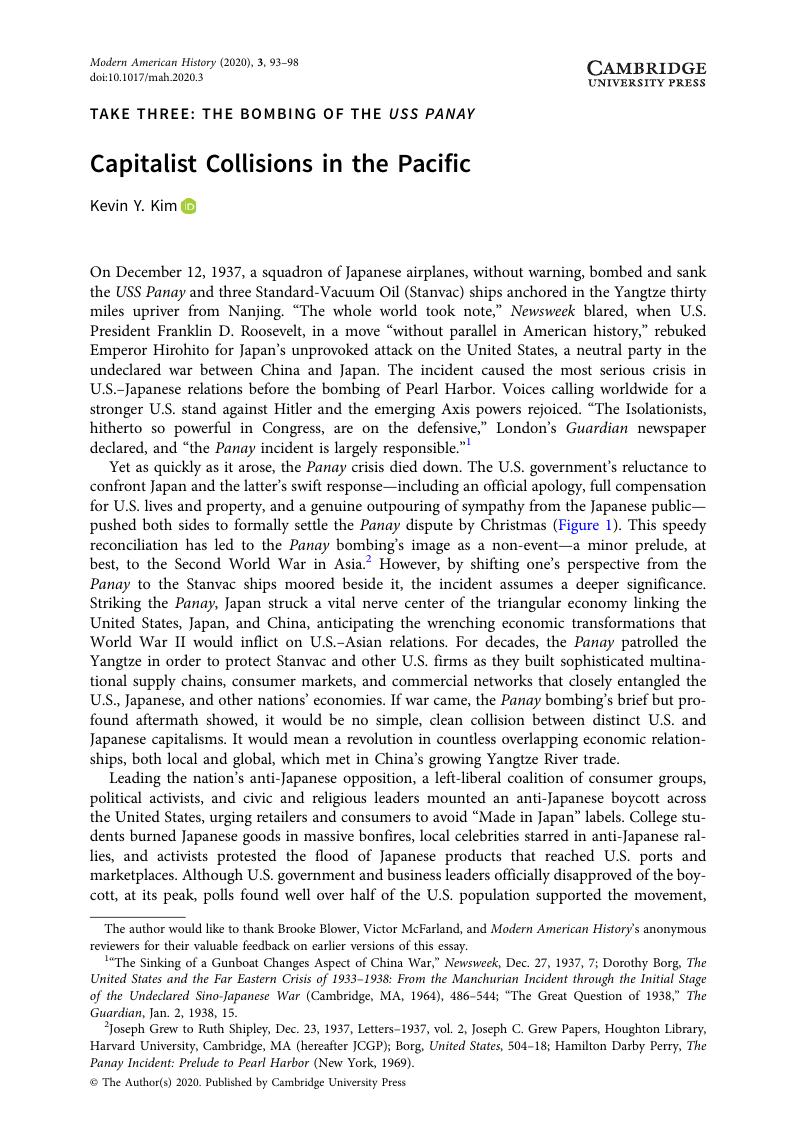No CrossRef data available.
Published online by Cambridge University Press: 16 March 2020

The author would like to thank Brooke Blower, Victor McFarland, and Modern American History's anonymous reviewers for their valuable feedback on earlier versions of this essay.
1 “The Sinking of a Gunboat Changes Aspect of China War,” Newsweek, Dec. 27, 1937, 7; Borg, Dorothy, The United States and the Far Eastern Crisis of 1933–1938: From the Manchurian Incident through the Initial Stage of the Undeclared Sino-Japanese War (Cambridge, MA, 1964), 486–544CrossRefGoogle Scholar; “The Great Question of 1938,” The Guardian, Jan. 2, 1938, 15.
2 Joseph Grew to Ruth Shipley, Dec. 23, 1937, Letters–1937, vol. 2, Joseph C. Grew Papers, Houghton Library, Harvard University, Cambridge, MA (hereafter JCGP); Borg, United States, 504–18; Perry, Hamilton Darby, The Panay Incident: Prelude to Pearl Harbor (New York, 1969)Google Scholar.
3 “Revive Drive for Boycott of Japan Goods,” Women's Wear Daily, Dec. 20, 1937, 1; “Quarterly Survey,” Fortune, Apr. 1938, 109; Greater Boston Boycott Japanese Goods Committee, “Did Your Stockings Kill Babies? Yes, If—”, [1937], folder: Union Material, box 11, Florence Luscomb Papers, Schlesinger Library, Radcliffe Institute, Cambridge, MA.
4 “Hides Jap Name Plate,” The Lather, Aug. 1938, 14; National Research League, “Don't Buy Japanese Goods” [1938], folder: Japan, box 139, Jessie Lloyd O'Connor Papers, Smith College Special Collections, Northampton, MA; Angus McStay, “Sheer Symmetry,” Maclean's Magazine, Dec. 1, 1938, 24; B. J. Perkins, “Europe Still to Cash in on Anti-Japan Feeling,” Women's Wear Daily, Feb. 8, 1938, 8.
5 Glickman, Lawrence B., “‘Make Lisle the Style’: The Politics of Fashion in the Japanese Silk Boycott, 1937–1940,” Journal of Social History 38, no. 3 (Spring 2005): 582–3CrossRefGoogle Scholar; Becker, Nathan M., “The Anti-Japanese Boycott in the United States,” Far Eastern Survey 8, no. 5 (Mar. 1939): 49–55CrossRefGoogle Scholar.
6 “Reactions Vary in Congress on Panay Sinking,” New York Herald Tribune, Dec. 14, 1937, 4.
7 Anderson, Irvine H., The Standard-Vacuum Oil Company and United States East Asian Policy, 1933–1941 (Princeton, NJ, 1975), 3–108Google Scholar; Cochran, Sherman, Encountering Chinese Networks: Western, Japanese, and Chinese Corporations in China, 1880–1937 (Berkeley, CA, 2000), 12–42Google Scholar; Perry, The Panay Incident, 17.
8 “American Diplomacy Faces New Tests,” The Commercial and Financial Chronicle, Dec. 18, 1937, 3875; Masland, John W., “Commercial Influence upon American Far Eastern Policy, 1937–1941,” Pacific Historical Review 11, no. 3 (Sept. 1942): 293–4CrossRefGoogle Scholar; E. M. Van Voorhees, “Political and Economic Conditions in China and Japan,” Nov. 22, 1938, 16, folder 15, box 184, Thomas W. Lamont Papers, Baker Library, Harvard Business School, Cambridge, MA; “Forum of Executive Opinion,” Fortune, Sept. 1940, 114.
9 Wilkins, Mira and Hill, Frank Ernest, American Business Abroad: Ford on Six Continents (New York, 2011), 255CrossRefGoogle Scholar; Stephen Bell, “International High Lights,” Commerce and Finance, Dec. 25, 1937, 702; “An Editorial,” Commerce and Finance, Jan. 8, 1938, 8; Joseph Grew to Katsuji Debuchi, Dec. 19, 1938, Letters–1938, vol. 3, JCGP.